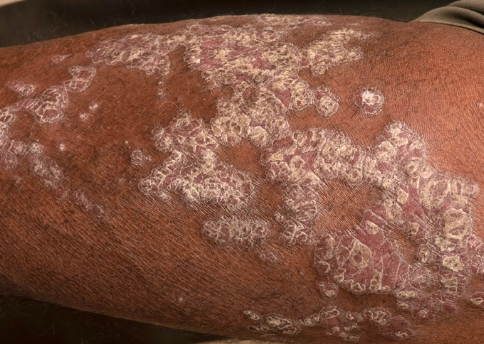An overview of plaque psoriasis, including diagnosis, management and treatment options
Whilst there are several different types of psoriasis, plaque psoriasis is the most common form of the condition and accounts for 80-to-90 per cent of cases, which is why it is known as psoriasis vulgaris. People generally have one type of psoriasis at a time, however it is possible to have two different types together at the same time. One type may transition into another type, and can worsen in severity.
According to the HSE, the symptoms include dry, red lesions (plaques) that are covered in silver scales. While they can appear anywhere on the body, the most common sites of inflammation are usually the knees, elbows, lower back or scalp. They cause itching and may be painful, or both, and when the disease is particularly severe, skin around the joints may also crack and bleed. The fact that plaque psoriasis can appear on the scalp can prove to be a diagnostic challenge, as scalp psoriasis is a separate condition unto itself.
Other types of psoriasis include nail psoriasis, guttate psoriasis, and inverse ( flexural) psoriasis (affects folds or creases in the skin). Less-common forms of the condition include pustular psoriasis, palmoplantar psoriasis, acropustulosis (causes pustules to appear on your fingers and toes), and erythrodermic psoriasis (affects almost all the skin on the body).

Plaque psoriasis. Image courtesy of NHS England
Most types of psoriasis go through cycles, which can sometimes last weeks or months. A typical presentation of plaque psoriasis is shown in Figure 1.
For most people, their skin cells grow, mature and drop off in flakes during a three-to- four week period. However, in psoriasis, skin cells grow faster than usual and this process takes only three-to-seven days. This means that cells that are still newly-developed build up quickly on the skin and this results in flaky, crusty patches and the resultant scaling.
There is some research to suggest that the root cause may be a problem with a person’s immune system and the T-cells used to fight- off invading germs and infections. However, in plaque psoriasis, these T-cells may be attacking healthy skin cells because of some dysregulation in the immune system. Family history is also considered to be a risk factor — it does not always follow that a person will get psoriasis if a relative has it, but it does make it more likely. Patients should also be reassured that psoriasis is not contagious.
According to the HSE, other factors that can trigger psoriasis include:
- Hormonal changes (predominantly for women, for instance during puberty and menopause).
- Smoking.
- High levels of stress.
- Drinking too much alcohol.
- Throat infections (can make a person prone to guttate psoriasis).
- A skin injury, for example a cut, scrape, insect bite or sunburn (sometimes referred to as the ‘Koebner phenomenon’).
- Certain medications, such as anti- inflammatories, ACE inhibitors, lithium and some antimalarial medicines.
- Other immune disorders, such as HIV. In addition, sudden exposure to cold weather can sometimes trigger a flare-up. It is generally thought that psoriasis improves in warmer climates and gets worse in colder ones.
For people living with psoriasis, the Irish Skin Foundation recommends the following preventive measures to avoid a flare-up. - Do not scrub the skin or take a bath or shower in hot water – use warm water only. Pat dry your skin dry after cleansing rather than rubbing.
- Keep the skin well moisturised. Applying a moisturiser immediately after a shower or bath will help lock-in moisture. Emollients and soap substitutes form an integral part of treatment.
- Keep nails trimmed.
- If facial psoriasis is a problem, consider skipping a day between shaves, change the razor blade often or use an electric razor. uWear cotton next to your skin, as it is much less likely to irritate the skin compared with other fabrics.
- Sun protection. As stated above, psoriasis can benefit from sunlight, however sunburn can cause psoriasis flares.
Treatment for plaque psoriasis is aimed at stopping skin cells from growing too quickly and removing the scales. Topical therapies include ointments and creams, oral or subcutaneous medications, and sometimes light therapy (phototherapy). The treatment path depends upon the severity of the condition and how responsive it has been to previous treatments. However, even when successful treatment has been initiated, sometimes the psoriasis will return.
For mild-to-moderate psoriasis, the most commonly-prescribed treatment is topical corticosteroids. These are available in a variety of forms, such as creams, oils, ointments, gels, lotions, sprays, foams and shampoos. Topical corticosteroids vary in strength and this will be dictated by the severity of the disease.
Synthetic forms of vitamin D are sometimes used in an effort to slow skin cell growth. Retinoids, calcineurin inhibitors, salicylic acid shampoos and solutions, coal tar and anthralin are also sometimes used, depending on the nature of the psoriasis.
Whilst plaque psoriasis is a troubling condition that impacts quality of life, when used correctly and with self-care to avoid triggers, there are more options available to sufferers than at any time in the past.
References on request







